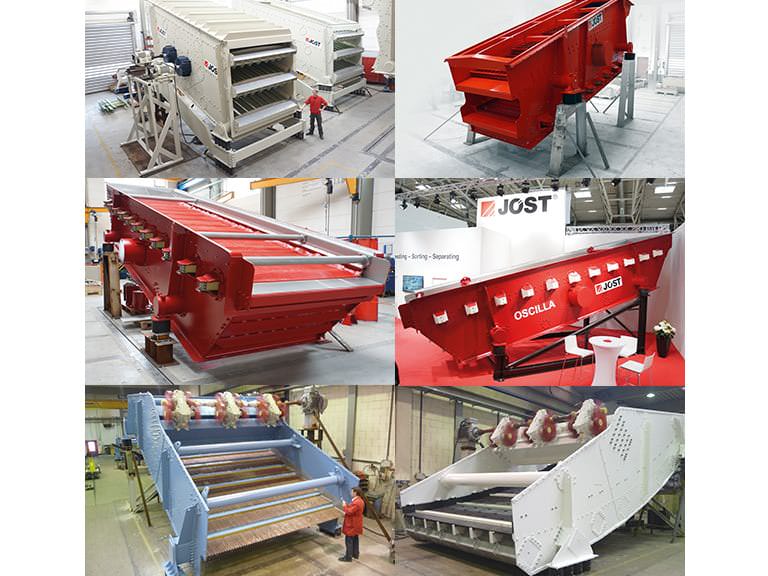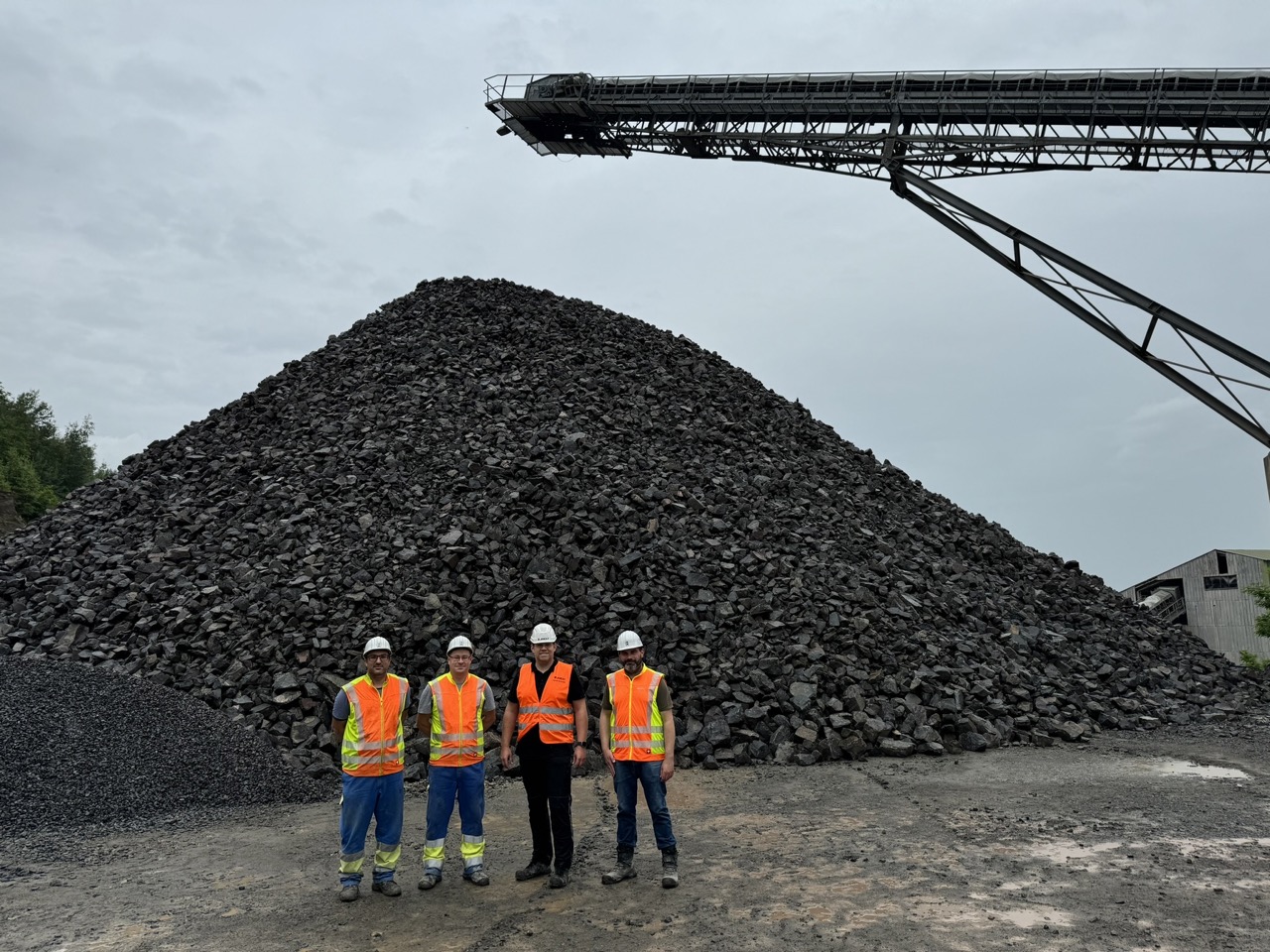MINING, MINERALS & QUARRYING
Which screen for which application?

The screening solutions offered by JOEST are as diverse as the bulk solids they are used to process.
In the basic industry range, the products screened range from hard rock and sands through coal to all types of ore. These are screened in both wet and dry processes. For difficult-to-screen products, special machines are available. But for recycling too, JOEST can always supply the corresponding screen. With the wide range of different potential applications, the question remains: “Which JOEST screen is used for which material?” The following insight into the JOEST screen portfolio clearly shows: No matter how different the materials to be screened are, customers can find the right solution at JOEST.
OSCILLA Flip-Flow Screen
JOEST’s OSCILLA flip-flow screen presents the ideal solution for processing difficult-to-screen materials. OSCILLA is suitable for a wide range of recycled products, but also for heavy products from the mining and non-metallic minerals sectors. The feed size is typically between 0 and 100 mm. OSCILLA is based on a resonance system in which the inner frame of the screen is set in relative motion in response to the motion of the directly excited outer screen box. This causes the screen mats to tense and then relax. The circular and linear vibration of the outer screen box also generates an additional throw component, with which high acceleration over 50 g can be obtained.
A completely new leaf spring system patented by JOEST enables much higher stroke and acceleration than conventional flip-flow screens. The new leaf spring design is not only extremely durable, it makes the adjustment of the stroke and acceleration very easy without the need for any control system. With this design, a multi-deck screen with flip-flow deck and a combination with conventional screening surfaces in the upper deck can be built without any problems. All available screen deck systems from wire mesh to perforated plate, finger screens or PU panel systems can be used.
TopSpin Finger Cascade Screen
For pre-separation in recycling plants, cascade screens are increasingly used for difficult-to-screen products. Their advantage is that they screen out long pieces with almost no blockages The finger cascade screen works on the basis of a circular vibratory screen with higher than average acceleration values, generated via a JOEST shaft drive. Thanks to the combination of high acceleration with the conical opening finger screen system in cascade arrangement, the feed material is first broken and then screened with almost no blockages. For best separation results, our finger cascade screens are equipped with an impact bottom for optimum product distribution and with additional turning of the feed
material. The screen cut size can range between 30 – 200 mm.
TOPCILLA Combination Screen
TOPCILLA combines the advantages of the TopSpin finger cascade screen in the top deck with the unique OSCILLA
flip-flow screen in the bottom deck. Key application is the processing of recycling materials, such as household and commercial waste, ASR, waste incineration slag, packaging waste and other heterogeneous material mixes.
Circular Motion Screen
Circular motion screens are used for the pre- or final classification of free flowing, medium- to coarse-grained bulk materials. The basic motion of this screen is circular motion. Typically designed with a pitch of 10° to 30°, this screen enables the optimum throughput for just about any application. The variety of possible screening surfaces – perforated plate, polyurethane panels or wire cloth – enhances the versatility of circular motion screens.
‘Tapping”’-type cleaning devices can be installed below the screening surface to avoid screen blinding when screening
under difficult conditions. The screens are generally fitted with an impact area and, if necessary, one or more cascade steps to turn the feed material. Circular motion screens can be built with up to three screen decks stacked above each other. Depending on the design and size of the screens, proven unbalance motors, lubricated shaft drives or, for very high loads, greaselubricated exciters are available as drive units.
Linear Motion Screen
Linear motion screens are used to meet high requirements for separation efficiency in almost all industries. The largest
possible screen areas for very high capacity screening of minerals can be obtained with linear motion screens. The linear motion screens can be built to a max. screen width of 4.5 m. Screen lengths up to 10 m are possible. With an isolated vibrating frame, these screens can weigh up to 60 t.
STABROFLEX and STABROFIX Finger Rod Screens
The STABROFLEX is used to screen bulk solids that are prone to sticking and cannot be screened on conventional square mesh. With its sturdy structure, the STABROFIX is used for coarse pre-separation, but especially to relieve the load on downstream crushers. In these two systems the screen decks are stepped above each other. On each screen deck the rods are fixed at one side. The rods are vibrated by an unbalance drive and the material itself. This allows screening without any blockages and, thanks to the steps, continuous turning of the feed material. The rods fixed in polyurethane blocks in the STABROFLEX system enable a strong motion relative to the base vibration of the actual screen box. This leads to a self-cleaning effect, with which difficult-to-screen bulk solids can be separated. The rods are screwed on to the cross-beams at one side. The Stabrofix system enables almost blockage-free screening as it provides a maximized open screening area with conical opening gap widths between 30 – 300 mm.
Grizzly with STABROFLEX
Depending on the geological factors, in the quarrying of natural stone products (e.g. limestone, greywacke, porphyry, diabase, etc.) the material extracted can often contain a more or less high content of soil and clay. It is necessary to combat the risk of these coarse components blocking machines and the clay blinding the screening surface, especially at high air humidity or when handling wet material. With a special screen – which is fed by troughed belt conveyor – these requirements can be met. First the product is distributed over the bottom of the conveyor, which is lined with thick rubber to minimize adhesion and absorb the shock energy of the feed material. The subsequent separation is effected with a screening section designed as a special grid system. The machine is equipped with an upstream
protection deck, depending on the grain size of the product to be fed and the desired screen cut of 10 up to 20 mm. The self-induced vibrations of the Stabroflex screen cascades – which overlay the natural vibrations of the feeder – ensure improved cleaning of the screen surface.
GRECCO Screen
Bulk solids containing fines content that blind conventional screening surfaces due to the adhesion of dust particles
can be screened maintenance-free using JOEST GRECCO screens. Steel bars with different weights cast in cross beams on one side are excited by the vibrating screen and perform transversal vibrations. The screen gaps can unblock
themselves, eliminating any pegged particles and material adhesion. Design measures at the end of the bars prevent excess amplitudes. Designed as a circular or linear motion screens broadens the potential applications. The system has already proven very efficient for processing run-of-mine products and at a rate of30 000 t.
Banana Screen
Banana screens are high-capacity vibrating screens developed according to the latest technologies and designed with the application of the “thin-film theory” to improve screen efficiency with the fast screening of fines. The banana screens are, as the conventional models, built up to a max. screen width of 4.27 m. Screen lengths up to 10 m are possible.
Dewatering Screen
Linear-motion screens were developed primarily for sand dewatering and are now used in all types of industries.
With the steep throw angle and high accelerations, extremely low residual moisture contents are obtained.
Wet-Sizing Screen
Wet-sizing screens are used to increase the straight throughput rate and for sharper separation points. Furthermore, they can be used as washing screens. Wet-sizing screens can be built as linear or circular motion screens.
AT Mineral Processing Europe 05/2015
Weitere Beiträge
JOEST delivered two high-performance vibrating feeder including tunnel frame, discharge chute and needle gate, each one feeding gabbro up to an edge length of 700 mm as a free stockpile discharge. Our focus was on a robust, blockage-free, wear-optimized and installation-friendly design.
Under the motto #JOESTogether, we organized for the first time an EM pack-watching on our site. It was a fantastic event where we celebrated our community and team spirit.
On the occasion of the farewell of the long-serving managing director, the entire staff of JOEST organized a collective fundraising campaign for the nearby children’s hospice Gut Feismann. A total of over 1,200 euros was collected by the #JOESTeam and ultimately rounded up to 3,500 euros by the management.
Münster
The Job Fair 2024 in Münster was a complete success for us. We are especially proud of our first-time participation as exhibitors.






